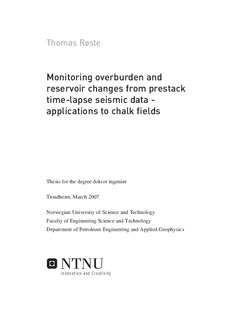| dc.description.abstract | Reservoir compaction due to hydrocarbon production has been observed in several North Sea reservoirs, especially the chalk reservoirs in the southern part. This compaction leads to changes in porosity and permeabilities which have implications for production and the production performance. In addition, reservoir compaction is often associated with stretching and arching of the overburden rocks and subsidence of the sea bed. The change in geomechanical stress state for the overburden rocks might cause damage in existing wells. It is therefore of significant importance to monitor these changes during production not only for the reservoir itself but also for the overburden rocks. This information can be obtained from well logs; however, wells in most reservoirs are sparse and widely spread, making time-lapse seismic data an important complementary tool.
Since compaction and stretching cause changes in both layer thickness as well as seismic velocities, it is crucial to develop methods to distinguish between the two effects. A new method based on detailed analysis of prestack time-lapse seismic data is introduced to discriminate between layer thickness and velocity changes. A key parameter in this discrimination process is the dilation factor, α, which is the relative velocity change divided by the relative thickness change within a given layer. This method incorporates lateral variations in relative velocity changes by utilizing zero-offset and offset-dependent time shifts.
Monitoring fault movements is important to avoid the complications associated with wells crossing faults that might be reactivated due to reservoir production. In addition, reactivation of overburden faults near the reservoir zone might lead to leakage of hydrocarbons and affect the reservoir drainage patterns. This thesis shows that growing faults can be obtained from prestack time-lapse seismic data. A growing fault tip appears as a distortion pattern with characteristic time shift versus offset signatures. From raypath considerations and modeling, the position and vertical extent of a distortion zone can be determined. The distortion patterns disappear if the time-lapse data is stacked, meaning that prestack data contains crucial information. The correlation between a time-lapse distortion zone and a growing fault tip is investigated on high quality prestack time-lapse seismic ocean bottom cable (OBC) data from the Valhall Field. A compacting reservoir zone exists directly beneath this fault tip, validating that a growing fault might cause the observed anomalies. Growing faults complicates the interpretation of time-lapse data since large vertical (in addition to lateral) variations in thickness and velocity changes occur. This thesis presents an extended method to estimate the dilation factor (α) in such cases. This method can be viewed as a simplified version of time-lapse tomography, but involving fewer unknown parameters, giving more stability to the estimated changes in thickness and velocity. In addition, the presented method is faster and cheaper than a full tomographic method.
In many reservoirs, 30-40% of the oil reserves remain unproduced. To identify undrained areas and detect drainage patterns, it is crucial to monitor the reservoir changes during production. Reservoir monitoring leads to saved costs due to reduced number of misplaced wells and increased production because of optimized well planning. From time-lapse amplitude variation with offset (AVO) analysis, it is possible to estimate reservoir pressure and saturation changes. This thesis introduces a new method which also includes compacting reservoirs. This is initially a three-parameter problem, including pressure and saturation changes and compaction. However, from laboratory measurements, the reservoir compaction is related to the pressure and saturation changes. Using an empirical relation between porosity, saturation, and pressure changes, the problem is reduced to involve only the pressure and saturation changes, which can be solved from time-lapse AVO analysis. | nb_NO |
